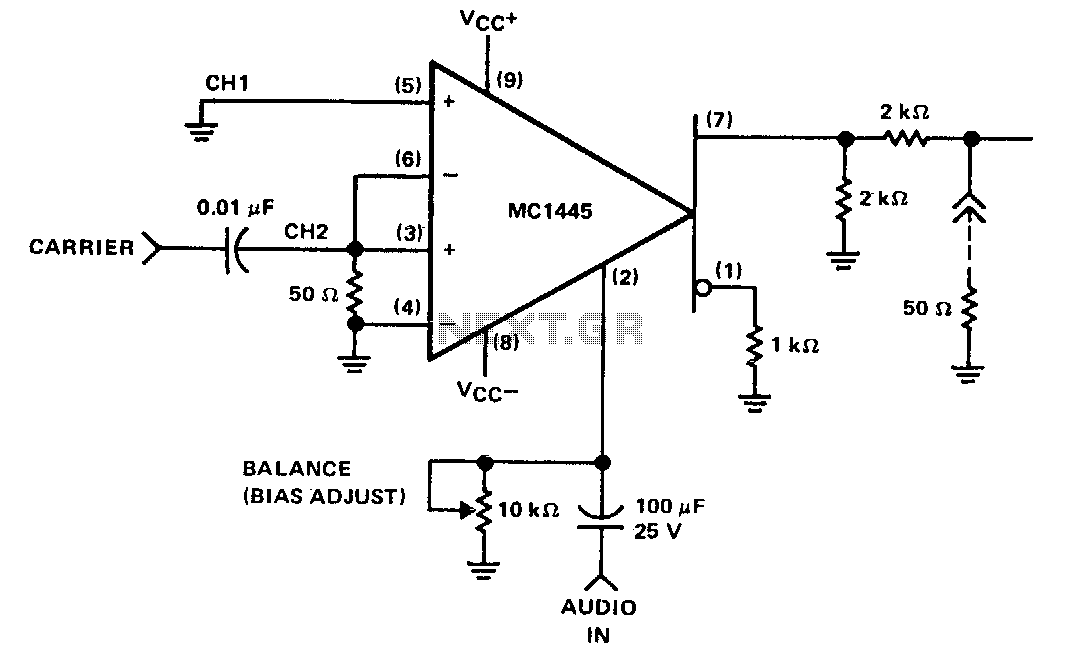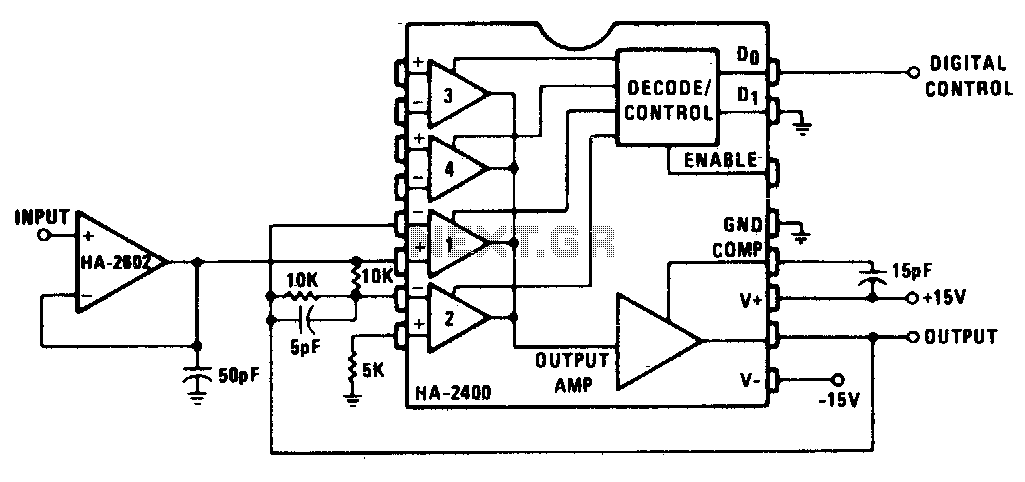
Balanced-modulator

When the carrier level is sufficient to activate the cross-coupled pair of differential amplifiers, the modulation signal applied to the gate will be switched at the carrier frequency between the collector loads. This switching results in the modulation being multiplied by a symmetrical switching function. If the modulation gate maintains its position in the linear region, only the first harmonic will be present. To achieve balance in the MC1445 modulator, equal gain must be obtained in the two separate channels. Additionally, to remain in the linear region, the modulation input must be limited to approximately 200 mV peak-to-peak. Due to the sensitivity of the gate bias point to the amount of carrier suppression, a high-resolution, 10-turn potentiometer should be utilized.
The MC1445 modulator is a critical component in various communication systems, particularly in applications requiring frequency modulation. The modulation process is initiated when the carrier signal reaches an adequate level, which allows the differential amplifiers to operate effectively. The modulation signal, when applied to the gate, is subjected to a switching mechanism that occurs at the carrier frequency. This switching action effectively multiplies the modulation signal by a symmetrical switching function, generating a modulated output that retains the desired characteristics of the original modulation signal.
In maintaining the integrity of the modulation process, it is essential for the modulation gate to remain within the linear region of operation. This requirement ensures that only the first harmonic of the modulation signal is present in the output, which is crucial for maintaining signal fidelity. The input to the modulation gate must be carefully controlled, with a maximum input voltage of approximately 200 mV peak-to-peak being recommended. Exceeding this threshold could push the modulation gate outside of its linear operating region, resulting in distortion and undesirable harmonics.
Achieving balance between the two channels of the MC1445 modulator is vital for optimal performance. Equal gain in both channels ensures that the modulation process is symmetrical, which is necessary for effective signal transmission. A high-resolution, 10-turn potentiometer is recommended for adjusting the gate bias point. This component allows for precise control over the biasing conditions, which is particularly important given the sensitivity of the gate bias to variations in carrier suppression. By utilizing a potentiometer with fine adjustments, the user can maintain the necessary balance and linearity in the modulation process, thereby enhancing the overall performance of the modulator in communication applications.When the carrier level is adequate to switch the cross-coupled pair of differential amplifiers, the modu· lation signal, which has been applied to the gate, will be switched at the carrier rate, between the collector loads. When switching occurs, it will result in the modulation being multiplied by a symmetrical switching function.
If the modulation gate remains in the linear region, only the first harmonic will be present. To balance the MC1445 modulator, equal gain must be achieved in the two separate channels. To remain in the linear region, the modulation input must be restricted to approximately 200 m V pk-pk. Because the gate bias point is sensitive to the amount of carrier suppression, a high-resolution, 10-tum potentiometer should be used.
🔗 External reference
The MC1445 modulator is a critical component in various communication systems, particularly in applications requiring frequency modulation. The modulation process is initiated when the carrier signal reaches an adequate level, which allows the differential amplifiers to operate effectively. The modulation signal, when applied to the gate, is subjected to a switching mechanism that occurs at the carrier frequency. This switching action effectively multiplies the modulation signal by a symmetrical switching function, generating a modulated output that retains the desired characteristics of the original modulation signal.
In maintaining the integrity of the modulation process, it is essential for the modulation gate to remain within the linear region of operation. This requirement ensures that only the first harmonic of the modulation signal is present in the output, which is crucial for maintaining signal fidelity. The input to the modulation gate must be carefully controlled, with a maximum input voltage of approximately 200 mV peak-to-peak being recommended. Exceeding this threshold could push the modulation gate outside of its linear operating region, resulting in distortion and undesirable harmonics.
Achieving balance between the two channels of the MC1445 modulator is vital for optimal performance. Equal gain in both channels ensures that the modulation process is symmetrical, which is necessary for effective signal transmission. A high-resolution, 10-turn potentiometer is recommended for adjusting the gate bias point. This component allows for precise control over the biasing conditions, which is particularly important given the sensitivity of the gate bias to variations in carrier suppression. By utilizing a potentiometer with fine adjustments, the user can maintain the necessary balance and linearity in the modulation process, thereby enhancing the overall performance of the modulator in communication applications.When the carrier level is adequate to switch the cross-coupled pair of differential amplifiers, the modu· lation signal, which has been applied to the gate, will be switched at the carrier rate, between the collector loads. When switching occurs, it will result in the modulation being multiplied by a symmetrical switching function.
If the modulation gate remains in the linear region, only the first harmonic will be present. To balance the MC1445 modulator, equal gain must be achieved in the two separate channels. To remain in the linear region, the modulation input must be restricted to approximately 200 m V pk-pk. Because the gate bias point is sensitive to the amount of carrier suppression, a high-resolution, 10-tum potentiometer should be used.
🔗 External reference
